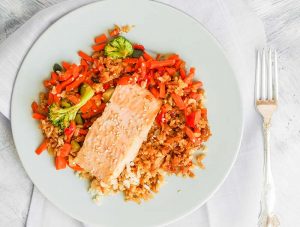Whether they are salted, roasted, raw or coated, for many people, nuts are a favourite in any shape or form!
In addition to tasting great, nuts also offer an array of nutritional benefits from boosting your fibre intake to being a source of protein and healthy fats. But often I’m asked which is the healthiest.We will be looking at a selection of nuts including almonds, walnuts, pistachios, cashews and peanuts to find out which is the best one for you.
How much should I be eating each day?
As recommended by the Australian Dietary Guidelines, a small handful of nuts (30 grams) can be a fantastic addition to your diet. As a guide, 30 grams is roughly 20 almonds, 9 walnut or 30 pistachio kernels, 15 cashews or 30 peanuts.
Nutritional benefits
Eating nuts can lead to greater satiety, i.e. helping you feel fuller for longer throughout the day. Studies have shown that the inclusion of nuts in a balanced diet can improve appetite and assist with weight loss or maintenance.
Protein and healthy fats
Protein is important, not only to affect appetite and satiety, but it also helps preserve lean muscle mass. Nuts are a great source of protein, providing approximately 9.5% of the recommended daily intake for the average adult woman in every 30g serve. The inclusion of healthy fats is really important for your diet and all nuts contain a mix of fats, mostly being your healthy mono and polyunsaturated fats. Essential fatty acids such as Omega-3 and 6 are crucial for growth and development, forming cell membranes and playing a role in a healthy immune system. Although we do need a small amount of healthy fats in our diet, too much can lead to weight gain. Including good sources of fats in your diet, like nuts that are rich in omega-3, can decrease the risk of developing cardiovascular disease and decrease the impact of ageing on brain function, so you’ll be as sharp as a tack for longer!
Fibre
Nuts are another way to include more fibre in your diet. Helping to keep your gut healthy and happy! In a study looking at nut and seed consumption, women who consumed an average of 15 grams of nuts per day had a reduced likelihood of developing colon cancer compared to women who did not consume any. Out of the 5 different types of nuts reviewed, pistachios, almonds and walnuts contain the most fibre, making up 10% of your recommended daily intake.
Sodium
Nuts are naturally low in salt, but it is worth keeping an eye on the packaging and sodium content as salted varieties are also common. We get enough salt from food and do not need extra sources, so I always recommend going for an unsalted version. If you want an alternative for flavour, try lightly toasting raw nuts and/or use a spiced nut recipe to jazz up their flavour!
Which should I choose – raw or roasted?
A question I frequently get asked is whether raw or roasted nuts are better for you. Despite both still having a very similar nutrient content, some nutrients like B-vitamins and antioxidants are lost during the roasting process, so they are only slightly less nutritious than raw nuts. If you do prefer the taste of roasted nuts, opt for a dry-roasted variety over oil-roasted for a lower kilojoule snack.
With the dramatic rise in nut allergies seen in Australia, it is understandable that we all want to do everything we can to lower allergy risk. Current recommendations indicated that pregnant women should only exclude nuts from their diet if they have a pre-existing nut allergy. Otherwise adding nuts regularly in your diet can not only provide a good source of nutrition but may also help sensitise your baby while he or she is still developing.
So which nut is best?
They all offer a variety of nutrients in differing quantities so in my eyes, they are all great! If you can’t pick one type, why not mix it up and have a variety of them all. Whether it’s adding some to a salad or grabbing a small handful to munch on as you rush for the morning train, nuts can be a nutritious addition to your diet. Keep a portion in the car or in your work desk for a satisfying, delicious snack, but keep it limited to a 30-gram (small handful) portion.





